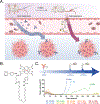Click chemistry: a transformative technology in nuclear medicine
- PMID: 37100960
- PMCID: PMC10293801
- DOI: 10.1038/s41596-023-00825-8
Click chemistry: a transformative technology in nuclear medicine
Abstract
The 2022 Nobel Prize in Chemistry was awarded to Professors K. Barry Sharpless, Morten Meldal and Carolyn Bertozzi for their pioneering roles in the advent of click chemistry. Sharpless and Meldal worked to develop the canonical click reaction-the copper-catalyzed azide-alkyne cycloaddition-while Bertozzi opened new frontiers with the creation of the bioorthogonal strain-promoted azide-alkyne cycloaddition. These two reactions have revolutionized chemical and biological science by facilitating selective, high yielding, rapid and clean ligations and by providing unprecedented ways to manipulate living systems. Click chemistry has affected every aspect of chemistry and chemical biology, but few disciplines have been impacted as much as radiopharmaceutical chemistry. The importance of speed and selectivity in radiochemistry make it an almost tailor-made application of click chemistry. In this Perspective, we discuss the ways in which the copper-catalyzed azide-alkyne cycloaddition, the strain-promoted azide-alkyne cycloaddition and a handful of 'next-generation' click reactions have transformed radiopharmaceutical chemistry, both as tools for more efficient radiosyntheses and as linchpins of technologies that have the potential to improve nuclear medicine.
© 2023. Springer Nature Limited.
Figures








Similar articles
-
Click Chemistry and Radiochemistry: An Update.Bioconjug Chem. 2023 Nov 15;34(11):1925-1950. doi: 10.1021/acs.bioconjchem.3c00286. Epub 2023 Sep 22. Bioconjug Chem. 2023. PMID: 37737084 Free PMC article. Review.
-
Mechanistic analysis of diverse click reactions along with their applications.Eur J Med Chem. 2025 Oct 15;296:117800. doi: 10.1016/j.ejmech.2025.117800. Epub 2025 May 28. Eur J Med Chem. 2025. PMID: 40517571 Review.
-
Exploring Metal-Free Click Reactions: New Frontiers in Glycochemistry and Bioconjugation.Bioconjug Chem. 2025 Aug 20;36(8):1553-1581. doi: 10.1021/acs.bioconjchem.5c00049. Epub 2025 Jul 17. Bioconjug Chem. 2025. PMID: 40673383 Review.
-
Cyclooctyne-Functionalized N-Heterocyclic Carbenes for Click Coupling of Sensing Oligonucleotides to Gold Surfaces.ACS Sens. 2025 Aug 22;10(8):6039-6047. doi: 10.1021/acssensors.5c01548. Epub 2025 Aug 7. ACS Sens. 2025. PMID: 40772859
-
Recent Advancements in CuAAC Click Approaches for the Synthesis of 1,2,3-Triazole Hybrid Compounds as Anticancer Agents.Chem Biodivers. 2025 Jul;22(7):e202403462. doi: 10.1002/cbdv.202403462. Epub 2025 Mar 11. Chem Biodivers. 2025. PMID: 39982025 Review.
Cited by
-
β-Silyl alkynoates: Versatile reagents for biocompatible and selective amide bond formation.Sci Adv. 2024 Sep 20;10(38):eadp7544. doi: 10.1126/sciadv.adp7544. Epub 2024 Sep 18. Sci Adv. 2024. PMID: 39292777 Free PMC article.
-
Decarboxylative click cycloaddition: an emerging strategy towards substituted 1,2,3-triazole derivatives.Mol Divers. 2025 Jun;29(3):2811-2827. doi: 10.1007/s11030-024-11014-4. Epub 2024 Nov 10. Mol Divers. 2025. PMID: 39522072 Review.
-
Therapeutic Approaches of Viral Gene Silencing by Small Interfering RNA: Strategies to Prevent the Emergence of Antiviral Resistant Escape Mutants.Pharmaceuticals (Basel). 2025 Jul 1;18(7):987. doi: 10.3390/ph18070987. Pharmaceuticals (Basel). 2025. PMID: 40732276 Free PMC article. Review.
-
Latest developments in coumarin-based anticancer agents: mechanism of action and structure-activity relationship studies.RSC Med Chem. 2023 Oct 20;15(1):10-54. doi: 10.1039/d3md00511a. eCollection 2024 Jan 25. RSC Med Chem. 2023. PMID: 38283214 Free PMC article. Review.
-
Click Chemistry and Radiochemistry: An Update.Bioconjug Chem. 2023 Nov 15;34(11):1925-1950. doi: 10.1021/acs.bioconjchem.3c00286. Epub 2023 Sep 22. Bioconjug Chem. 2023. PMID: 37737084 Free PMC article. Review.
References
-
- The Nobel Prize in Chemistry 2022., <www.nobelprize.org/prizes/chemistry/2022/summary> (2022).
-
- Huisgen R Centenary Lecture - 1,3-Dipolar Cycloadditions. Proc. Chem. Soc, 357–396, doi:10.1039/ps9610000357 (1961). - DOI
Publication types
MeSH terms
Substances
Grants and funding
LinkOut - more resources
Full Text Sources
Other Literature Sources

